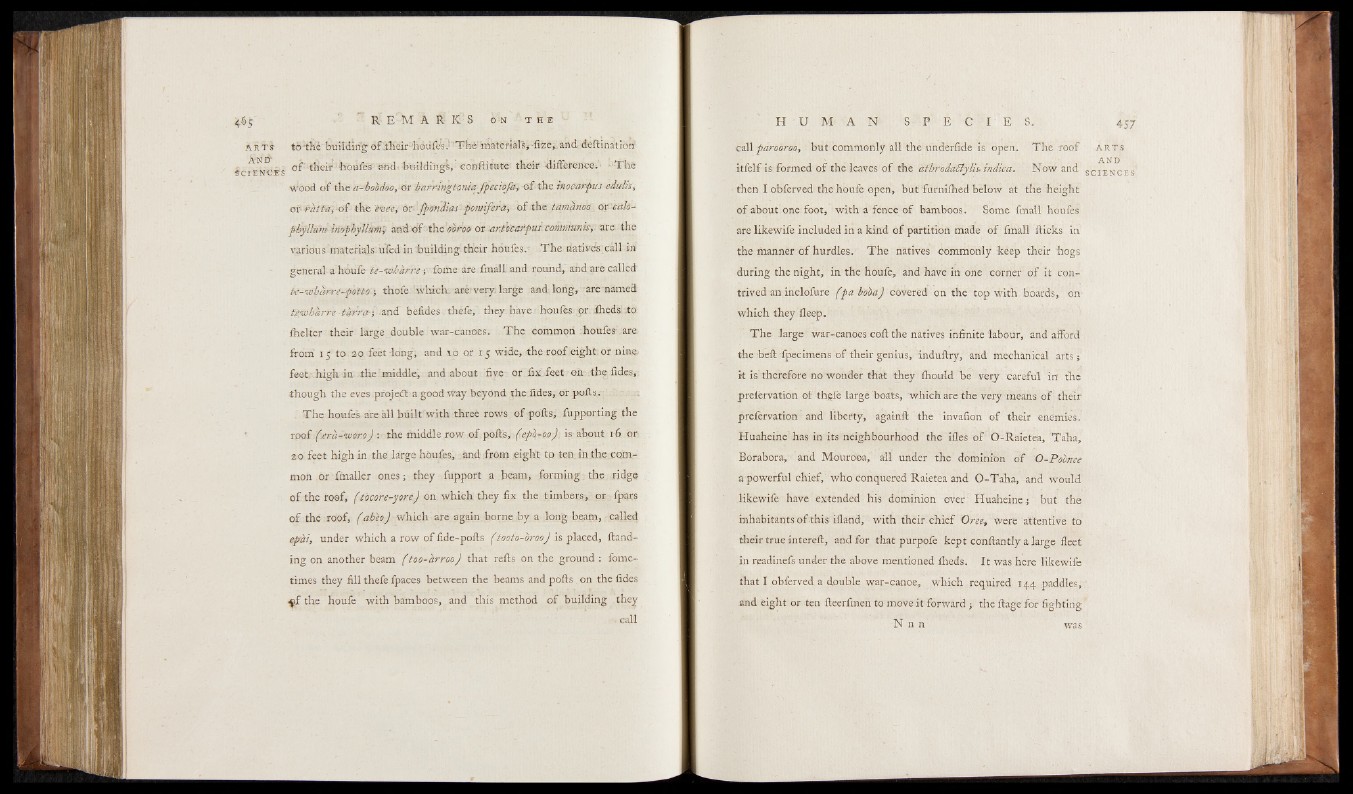
ÀRÂ&
À'ND'
SCIE N-C.ÊS
to'the-building o fÆeir-hèùfèV) Th é '-materials,-fize,_and deHinaitioii
oÈ tfeir fcôuÆs aiidt building^,: oo»ftitute their différence.' —Thé
wood o f the a-hoidoo, tir barringtonia fped'ofci-}-of the inocafpu's eduli’s,
or ratt-üy -of die èvee, or- jpondias powijera, o f the tamanoo:, or calo-
phyllummophyllum., and -of the doroo or antlcafpus communis, : are the
various materials:ufedin building their hoüfes.7 T h e fiativdsxâll ht
general a houle tc-i&hàrre ; fonic are flmall and. round, and are called
té-wbdr-ré-potto -, thofe ‘which, are'very; large and long, -are named
tjegahtrre tàrra-i .and bifideslthefe, they have; houfes or flieds to
lhelter their large double war-canoes. T h e common-houfes-.are
from 15 to 20 feet-long, and to or 15 wide, the roof'eight, or nine,
feet,-, high, in the middle, and about five, or fix feet on the fidcs,
though the eves projedt a.good way beyond the-Ades, or polls.
. Th e houfes are all b u ilfw ith three rows o f polls, fupporting the
roof .(.erà-'woro) the middle row of.polls, (epq^oo): is-about 16 or
20 feet high in the large houfes, indfirom eight tp ten in the com-
mon or fmaller onesj they fupport a beam, forming. the ridge
o f the roof, (tocore-yerej on which they fix the timbers, or fpars
o f the roof, ( aheo) which are again borne b y a long beam, called
epm, under which a row o f fide-polls ( tooto-oroo) is placed, Handing
on another beam ( too-àrroo) that relis on the ground : fome-
times they fill thefe Ipaces between the beams and polls on the fides
^ f the houfe with bamboos, and this method of building they
i call
call pdrooroo, but commonly all the underfide is open. The roof
itfelf is formed o f the leaves o f the atbrodaEtylis. indica. Now and
then I obferved the houfe open, but furnilhed below at the height
o f about one foot, with a fence of bamboos. Some fmall houfes
are likewife included in a kind o f partition made o f final! Hicks in
the manner o f hurdles. Th e natives commonly keep their hogs
during the night, in the houfe, and have in one corner o f it contrived
an inclofure (pa booa) covered on the top with boards, on-
which they lleep.
T h e .large war-canoes coH the natives infinite labour, and afford
the befi-fpecimens of their genius, indufiry, and mechanical arts
k is therefore no wonder that they Ihould be -very careful in the
prefervation o f thpfe large boats, which are the very means o f their
prefervation and liberty, againfi the invafion o f their enemies.
Huaheine has in its neighbourhood the files of O-Raietea, Taha,
Borabora, and Mourooa, all under the dominion o f O-Poonee
a powerful chief, who conquered Raietea and O-Taha, and would
likewife have extended his dominion over Huaheine j but the
inhabitants of-this ifland, with their chief Oree, were attentive to
their true intereff, and for that purpofe kept conflantly a large fleet
in readinefs under the above mentioned Iheds. It was here likewife
that I obferved a double war-canoe, which required 144 paddles,
and eight or ten fieerfmen to move it forward ; the flage for fighting
N n n
A R T S
AND
SCIENCES
was